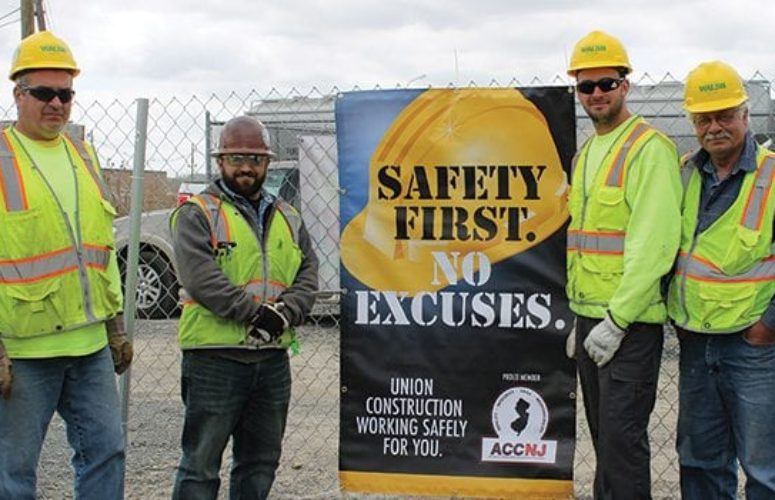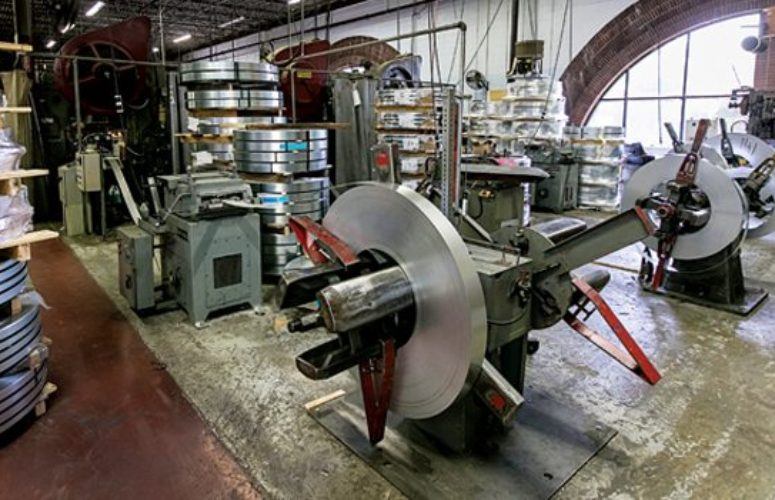
How Construction Trades Impact the Garden State’s Economy
New Jersey’s construction unions are cultivating teams of skilled workers to build the state’s infrastructure – and boost the local economy.
By Jennifer Lesser, Contributing Writer On Sep 11, 2017Like many of the Garden State’s most prominent business sectors, the construction industry is one that is always changing. Fortunately, New Jersey is home to construction unions that are not only doing their part to help developers, contractors and local and state governments hire trained, professional workers, but they’re also making a major impact on the local economy.
According to Jack Kocsis, Jr., chief executive officer of Associated Construction Contractors of New Jersey (ACCNJ), New Jersey’s construction industry contributes some $22 billion to the state’s gross domestic product each year. Salaries in the construction industry average $67,700, which is nine percent higher than all other private sectors in the state. A trade association representing general building contractors, construction managers, and heavy, highway and utility contractors in New Jersey, ACCNJ’s membership employs tens of thousands of skilled union craftworkers each year who are responsible for billions of dollars in commercial, industrial, heavy, highway, utility and institutional construction projects annually.
Better yet, the local construction industry seems to be experiencing a growth trend. Kocsis notes that 2016 was the first year ACCNJ members saw a significant increase in construction projects since 2009, after the economic downturn. However, the majority of the increases have been in private commercial projects instead of public works.
“We’re seeing an increase in water infrastructure projects, driven by the utilities themselves, primarily because we need more resiliency following Superstorm Sandy and because we’re using infrastructure that’s 50 or 100 years old. The same is true with electric and gas utilities,” he explains. Meanwhile, public projects are cropping up at the local level, as counties and municipalities look to redevelop abandoned commercial properties or build state-of-the-art police and fire services. “It’s no secret the bottom-line benefit of skill and expertise is productivity – the job is going to get done fast, efficiently and safely, on time and within budget,” he adds. “That directly translates into dollars saved for the owners and developers.”
It’s impossible to discuss the economic impact of construction unions without also detailing their important role in New Jersey’s transportation industry. “When you talk about the economic benefits of construction, you can’t ignore the fact that our members are the ones working on major projects like the Bayonne Bridge,” asserts Greg Lalevee, business manager of the International Union of Operating Engineers (IUOE) Local 825, which includes 7,000 members throughout the state of New Jersey and five counties in New York. The union’s membership ranges from laborers that operate heavy equipment for constructing buildings, roads and bridges to members who are manufacturing materials for asphalt and concrete plants.
“We are a corridor state with a large port, so from meeting the needs of the trucking industry to making improvements on the Garden State Parkway to supporting New Jersey’s tourism industry in the shore region, it’s our responsibility to cultivate the professional, skilled labor that helps goods and services move more efficiently – and do our part to contribute to the broader economy,” Lalevee explains.
That often means partnering with developers in a shared effort to bring projects to fruition that will positively impact local businesses and residents. “We’re always looking to partner with developers, and we’re happy to be part of any coalition or team that’s executing important projects for our state … like improvements in water and sewer infrastructure,” Lalevee adds. “We’re definitely experiencing growth, especially since Trenton straightened out the Transportation Trust Fund, and we’ve seen an explosion of projects this year revolving around improvements that have to be made in our state.”
Construction unions also help ensure that the skilled laborers that comprise their membership have the healthcare coverage and other benefits they need to take care of themselves and their families, in addition to paying taxes and Social Security and contributing to workers’ compensation and unemployment insurance, all of which protect the craftworkers and boost the state’s economy. And, of course, union workers are making a direct economic impact within their communities. “Our people are living and spending where they earn. Our children are born at the hospitals and attend the schools where we conduct our work,” explains Michael McLaughlin, president of International Brotherhood of Electrical Workers (IBEW) Local 456.
The unions may already play a crucial role in building communities throughout the state, but they’re also making sure they do their part to give back. “In addition to private commercial projects, our contractors work on public projects for municipalities and counties throughout the state. They are uniquely tied to their communities because they have built the schools, roads, municipal buildings, water treatment plants – you name it – that make up a town or city,” Kocsis says. Many union members donate their time or financial resources to philanthropic activities like building playgrounds or recreational spaces for children, participating in fundraisers and food drives, supporting veterans’ groups, or getting involved with charitable organizations like Big Brothers, Big Sisters, Ronald McDonald House, and Habitat for Humanity.
The responsibility to cultivate teams of skilled laborers means that the unions are also charged with the daunting task of staying on top of changes in a dynamic industry that’s directly impacted by changes in technology. “The construction industry is constantly changing, and anyone who does not change with it is destined to fail,” asserts Raymond M. Pocino, vice president and eastern regional manager of the Laborers’ International Union of North America (LIUNA). “Both LIUNA and its contractors attempt to not merely meet the standards of innovation and best practices, they work to set that standard … such as staying on top of technological changes.” LIUNA represents more than 20,000 New Jersey-based members who specialize in a broad spectrum of work including heavy and highway construction, building construction, environmental remediation, energy infrastructure, and residential construction.
Kocsis notes that in the private sector, there has been an uptick in the demand for construction in the healthcare industry, as the major healthcare systems across the state respond to the need for satellite clinics and walk-in emergency rooms. “We’re also continuing to see a lot of mixed-use residential and retail building, especially in the cities and the smaller towns along the rail lines,” he adds. “And the utilities are driving the upgrades of the state’s infrastructure.”
Indeed, in addition to meeting the needs of growing industries like healthcare, the state’s construction unions are addressing urgent issues like the state’s energy infrastructure needs as well as aging water and sewer systems. They are also a source of skilled labor that local businesses, healthcare organizations, and educational institutions are tapping to help facilitate their growth. “We’re efficient, well-trained workers, and we finish a job on time, on budget,” McLaughlin says. “If PSEG needs a new power plant, if a large pharmaceutical company wants to build a manufacturing facility, or if Rutgers University wants to build a chemistry building … they know they can hire our electricians to get even the most complicated jobs done correctly.”
Despite its growth, the local construction industry hasn’t been without its challenges in recent years. Construction unions have been saddled with the overwhelming task of meeting the growing demands for skilled laborers amid a dwindling pool of available talent. “While business is robust in the construction sector, the challenge is filling the jobs with experienced, professionally-trained individuals,” explains John Ballantyne, executive secretary-treasurer of the Northeast Regional Council of Carpenters (NRCC).
One of the largest trade unions on the East Coast, the NRCC represents nearly 40,000 men and women in Delaware and New Jersey and portions of Maryland, New York, and Pennsylvania, and equips their professional carpenters with the skills, training, and quality workmanship that are required in today’s construction industry. The New Jersey component of the Northeast Regional Council of Carpenters (NRCC) represents 17,000 union carpenters and signatory contractors, while its Carpenter Contractor Trust (CCT) promotes and markets the skills, talent, productivity, assets and expertise of union carpenters and contractors to the construction community and the public throughout the northeast region of the United States. “The traditional entry into the carpentry trade was a grandfather to father to son legacy, but this infusion of talent has diminished, so it’s the council and CCT’s function to promote the employment possibilities to those who might have never previously considered a carpentry career,” Ballantyne says.
The role of the construction union to fill those positions has become even more difficult as a result of the culture and aspirations of the state’s younger workforce. “The lack of qualified help is one of the greatest challenges that the construction industry and other trade-related sectors face. If builders and developers lack the human capital to hire, they cannot meet their construction and financial goals,” he explains.
But perhaps the most important role that construction unions play in the Garden State comes in the form of the training and educational opportunities that help keep their workers safe. “This is an inherently dangerous business, and our goal is always for our members to come home safe to their families every night,” Lalavee says. “It boils down to having the necessary skills and training to do their jobs safely … and that’s where we come in.”
One of the most significant offerings through the state’s construction unions are apprenticeship programs. For example, the NRCC’s craftworkers must attend a five-year apprenticeship program that includes extensive hands-on and classroom instruction at training facilities throughout the Northeast. Its new 100,000-square-foot, state-of-the-art training facility in Edison is under development and will be completed later this year. These programs enable workers to earn a paycheck while earning the equivalent of a college degree in the construction business.
“It’s tough to talk about LIUNA’s economic impact – or any of the union building trades’ economic impact for that matter – without discussing our education and training programs,” Pocino adds. The New Jersey Building Trades offers a free education to tens of thousands of residents each year. “The cost for these programs, developed in coordination and with input from employers, is absolutely nothing; there’s no worrying about paying tuition, and no being saddled with crippling student debt,” he says. “We train as many people each year as a major university, develop and deliver industry-specific programs on topics highly desired by employers, offer members continuing education classes for their entire careers, and we don’t charge for any of it. If that isn’t an enormous benefit to individuals, the construction industry, and the community-at-large, I don’t know what is.”
The unions also often have targeted programs to encourage membership; LIUNA’s Helmets-to-Hardhats helps transition former military personnel into the union, while the NRCC is heavily invested in its Sisters in the Brotherhood program, a campaign to increase the number of female carpenter apprentices. “Local unions should be made up of local people, and we expect the ‘face’ of our future workforce to reflect our society at large – especially in New Jersey,” Ballantyne says. “We’re about taking care of our members through good salaries, healthcare and retirement benefits … we’re ensuring that all of our members can make a good salary and spend that hard-earned money in the communities where they live.”
In 2016, the ACCNJ’s members and labor partners collectively invested more than $33.7 million for hundreds of safety training and education programs that benefited nearly 11,000 workers. “When workers are safe, insurance costs go down. Owners and developers look for contractors with good safety records. It’s an inherent part of the cost-savings,” Kocsis explains.
The NRCC has 13 training centers throughout its council, and over the past few years has spent millions of dollars to provide training facilities for thousands of apprentice carpenters. The organization’s new training facility in Edison will serve as the hub of training for more than 1,000 carpenter apprentices in the state of New Jersey. “Training and safety are two of the biggest things on which unions focus. We place an extremely high value on properly training all of members to ensure that our signatory contractors have a highly-skilled workforce,” Ballantyne says.
Meanwhile, construction unions are striving to help bridge the gaps that government officials and private industry can’t always fill by building a safe and productive workforce; that often means innovating labor-management programs focused on training and apprenticeship, health and safety, and business development. Ultimately, these organizations foster partnerships with contractors and employers with the goal of helping them save money and get the job done.
“We dispel the myth that unions and employers can’t get along. We consider it a success when the project owner, contractor and union laborer all win,” Pocino concludes. “It’s that mindset that has helped rebuild communities, support local businesses, and launch careers.”
Related Articles:






